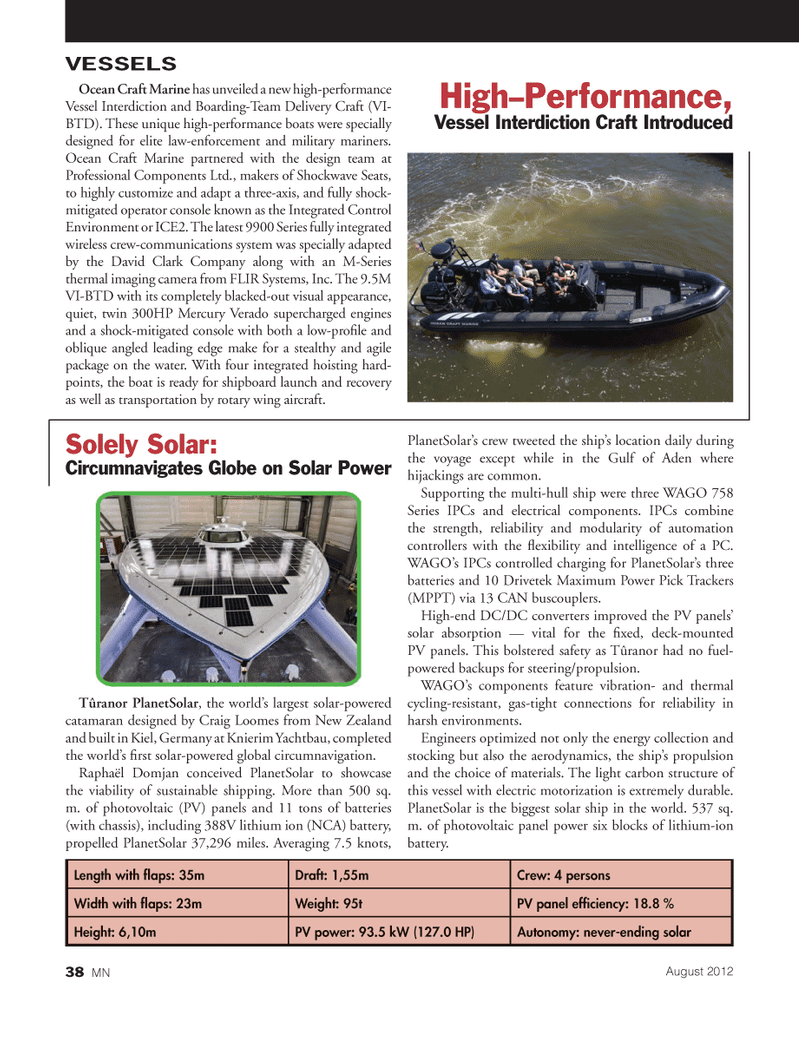
Page 38: of Marine News Magazine (August 2012)
Salvage & Recovery
Read this page in Pdf, Flash or Html5 edition of August 2012 Marine News Magazine
Ocean Craft Marine has unveiled a new high-performance Vessel Interdiction and Boarding-Team Delivery Craft (VI- BTD). These unique high-performance boats were specially designed for elite law-enforcement and military mariners. Ocean Craft Marine partnered with the design team at Professional Components Ltd., makers of Shockwave Seats, to highly customize and adapt a three-axis, and fully shock- mitigated operator console known as the Integrated Control Environment or ICE2. The latest 9900 Series fully integrated wireless crew-communications system was specially adapted by the David Clark Company along with an M-Series thermal imaging camera from FLIR Systems, Inc. The 9.5M VI-BTD with its completely blacked-out visual appearance, quiet, twin 300HP Mercury Verado supercharged engines and a shock-mitigated console with both a low-proÞ le and oblique angled leading edge make for a stealthy and agile package on the water. With four integrated hoisting hard- points, the boat is ready for shipboard launch and recovery as well as transportation by rotary wing aircraft. Tûranor PlanetSolar , the worldÕs largest solar-powered catamaran designed by Craig Loomes from New Zealand and built in Kiel, Germany at Knierim Yachtbau, completed the worldÕs Þ rst solar-powered global circumnavigation. Rapha?l Domjan conceived PlanetSolar to showcase the viability of sustainable shipping. More than 500 sq. m. of photovoltaic (PV) panels and 11 tons of batteries (with chassis), including 388V lithium ion (NCA) battery, propelled PlanetSolar 37,296 miles. Averaging 7.5 knots, PlanetSolarÕs crew tweeted the shipÕs location daily during the voyage except while in the Gulf of Aden where hijackings are common. Supporting the multi-hull ship were three WAGO 758 Series IPCs and electrical components. IPCs combine the strength, reliability and modularity of automation controllers with the ß exibility and intelligence of a PC. WAGOÕs IPCs controlled charging for PlanetSolarÕs three batteries and 10 Drivetek Maximum Power Pick Trackers (MPPT) via 13 CAN buscouplers. High-end DC/DC converters improved the PV panelsÕ solar absorption Ñ vital for the Þ xed, deck-mounted PV panels. This bolstered safety as T?ranor had no fuel- powered backups for steering/propulsion. WAGOÕs components feature vibration- and thermal cycling-resistant, gas-tight connections for reliability in harsh environments. Engineers optimized not only the energy collection and stocking but also the aerodynamics, the shipÕs propulsion and the choice of materials. The light carbon structure of this vessel with electric motorization is extremely durable. PlanetSolar is the biggest solar ship in the world. 537 sq. m. of photovoltaic panel power six blocks of lithium-ion battery. High?Performance, Vessel Interdiction Craft Introduced Solely Solar: Circumnavigates Globe on Solar Power VESSELSLength with ß aps: 35m Draft: 1,55mCrew: 4 personsWidth with ß aps: 23m Weight: 95t PV panel efÞ ciency: 18.8 % Height: 6,10mPV power: 93.5 kW (127.0 HP)Autonomy: never-ending solar 38 MNAugust 2012

 37
37

 39
39
